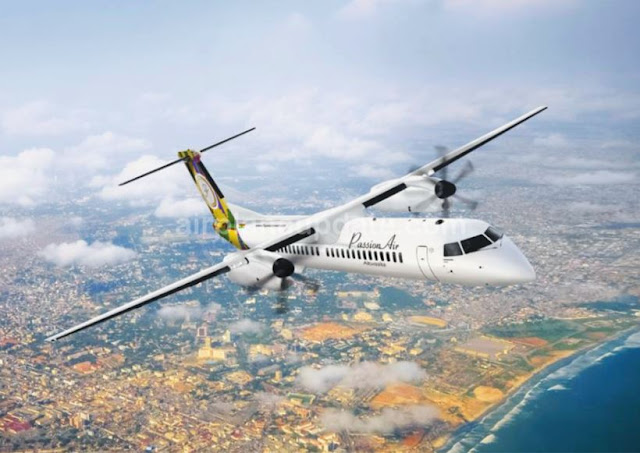Bombardier Dash 8 Q400 Specs, Interior, Cockpit, and Price – Bombardier Dash 8 Q400 is one of the quietest turboprop aircraft in the world developed by Bombardier Aerospace De Havilland Canada. The development of this aircraft is intended to meet the requirements of regional airlines for larger aircraft on high density routes and short distances. Q400 is the largest member of the Dash 8 family that can accommodate up to 80 passengers.
The Q400 program was launched in 1995 as a broad version of the Q300 series. The first flight of the Q400 aircraft was carried out in 1998 and entered commercial service in February 2000. The aircraft was equipped with a noise and vibration suppression (NVS) system introduced in the Dash 8 turboprop family in 1996.
The latest variant of the Q400 aircraft, the Q400 NextGen, was announced in March 2008. The new aircraft has improvements in the cabin environment, including LED lighting, new ceiling panels, sidewall windows and larger bins. Q400 NextGen participated in the 2012 FIDAE Air Show held in Santiago, Chile in April 2012.

In terms of electricity, the Q400 aircraft powered by an Allied Signal electric power system includes two starter / generators for DC power, two transformer units and two nickel cadmium batteries. There are two engine-driven AC generators to supply variable frequency AC power.
The Q400 aircraft landing mechanism features a retractable Menasco tricycle type landing gear. Each unit has twin wheels equipped with Goodrich anti-skid brakes. Two independent hydraulic systems are supplied by Parker Bertea Aerospace.
The fuel tank located on the wing of the aircraft has a total capacity of 6,526 l. The Q400 test aircraft became the first Canadian aircraft to fly using D7566 bio-fuel. D7566 is certified by the American Society for Testing and Materials (ASTM). Porter Airlines is Canada's first biofuel-powered revenue flight on its Q400 aircraft.

The avionics suite of Q400 aircraft supplied by Thales Avionics includes a flight management system, global positioning system and a traffic warning and collision avoidance system, TCAS II. The aircraft communication suite includes dual VHF navigation and S communication and transponder mode. Navigation equipment includes weather radar, proximity proximity warning receivers, radar altimeters, automatic direction finders, and distance measuring equipment.

The Q400 program was launched in 1995 as a broad version of the Q300 series. The first flight of the Q400 aircraft was carried out in 1998 and entered commercial service in February 2000. The aircraft was equipped with a noise and vibration suppression (NVS) system introduced in the Dash 8 turboprop family in 1996.
The latest variant of the Q400 aircraft, the Q400 NextGen, was announced in March 2008. The new aircraft has improvements in the cabin environment, including LED lighting, new ceiling panels, sidewall windows and larger bins. Q400 NextGen participated in the 2012 FIDAE Air Show held in Santiago, Chile in April 2012.

Bombardier Dash 8 Q400 Specs
The transverse section near the circle of the fuselage and the tail section are manufactured by Mitsubishi. The wings, tail plane, and front end of the fins are equipped with a de-icing system. The Q400 aircraft is equipped with a R408 type six bladed composite propeller supplied by Dowty. The propeller is equipped with an electric current removal system. Overall, the Q400 aircraft has a length of 32.84 m, a height of 8.36 m, and a wing span of 28.42 m.In terms of electricity, the Q400 aircraft powered by an Allied Signal electric power system includes two starter / generators for DC power, two transformer units and two nickel cadmium batteries. There are two engine-driven AC generators to supply variable frequency AC power.
The Q400 aircraft landing mechanism features a retractable Menasco tricycle type landing gear. Each unit has twin wheels equipped with Goodrich anti-skid brakes. Two independent hydraulic systems are supplied by Parker Bertea Aerospace.
The fuel tank located on the wing of the aircraft has a total capacity of 6,526 l. The Q400 test aircraft became the first Canadian aircraft to fly using D7566 bio-fuel. D7566 is certified by the American Society for Testing and Materials (ASTM). Porter Airlines is Canada's first biofuel-powered revenue flight on its Q400 aircraft.
Bombardier Dash 8 Q400 Engine and Performance
The Q400 aircraft is powered by two PW150A turboprop engines supplied by Pratt & Whitney Canada. Each engine is capable of producing an output power of 5,071 shp or 3,800 kW. The engine is equipped with full digital engine control (FADEC). With the support of the PW150A engine, the Q400 is capable of flying with a maximum cruise speed of 650 km / h with a maximum distance of 2,519 km.
Bombardier Dash 8 Q400 Cockpit and Avionics
The Q400 aircraft is equipped with a dual control cockpit that can accommodate pilot and co-pilot. The cockpit is integrated with an electronic flight instrumentation system (EFIS) with five high-resolution LCDs, 6 in x 8 in to display all flight information. The cockpit is also equipped with an emergency locator transponder, solid state cockpit voice recorder, and a holographic guidance system from Flight Dynamics.The avionics suite of Q400 aircraft supplied by Thales Avionics includes a flight management system, global positioning system and a traffic warning and collision avoidance system, TCAS II. The aircraft communication suite includes dual VHF navigation and S communication and transponder mode. Navigation equipment includes weather radar, proximity proximity warning receivers, radar altimeters, automatic direction finders, and distance measuring equipment.









No comments:
Post a Comment